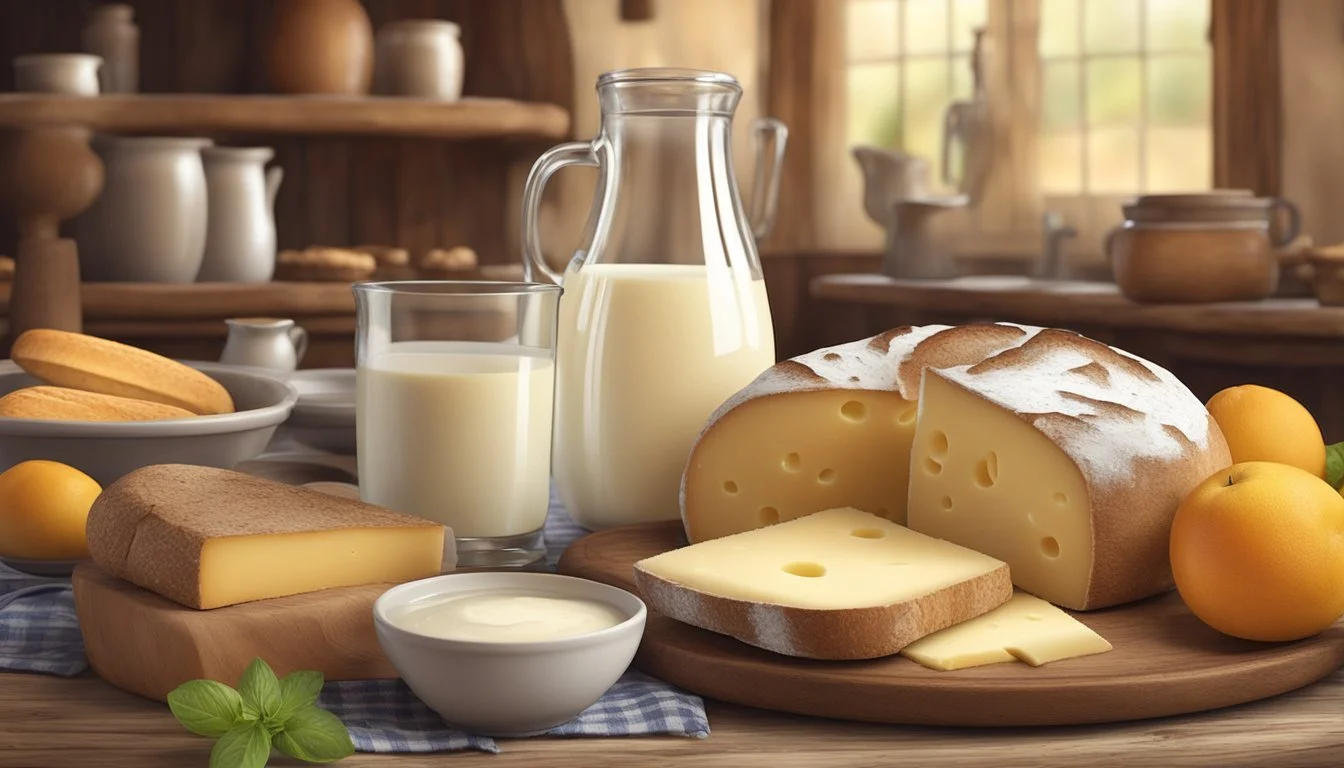Raw Milk in Traditional European Diets
Unveiling Cultural Significance
Raw milk has long been intertwined with the traditional diets of Europe, serving as a cornerstone of nutritional practice and cultural identity. Unlike many populations worldwide, Europeans show a high degree of tolerance for lactose, allowing them to consume milk and dairy products regularly. This relationship between Europeans and milk consumption is not merely a matter of habit but is deeply rooted in history and tradition. For centuries, raw milk and its derivatives have been staple foods, providing essential nutrients that have shaped dietary patterns across the continent.
The cultural significance of raw milk goes beyond its consumption as a beverage. It is the foundation for a variety of traditional fermented milk products, such as cheese and yogurt, that have been produced and consumed in Europe for thousands of years. These fermented products reflect the ingenuity of early European societies in food preservation, and they have become a part of the region's gastronomic legacy.
Moreover, these dietary habits, centered around milk, reflect a broader pattern of European diets that are characterized by a balance of animal-derived products, cereals, fruits, and vegetables. The European diet has evolved over time, influenced by factors like geography, climate, and socio-economic changes, yet the centrality of dairy, symbolized by raw milk, remains a consistent feature across various countries and cultures within Europe. The consumption of raw milk and its fermented products continues to offer an interesting lens through which to examine the rich tapestry of European dietary traditions.
Raw milk holds a significant place in traditional European diets, often embraced as a cornerstone of a raw milk whole foods diet. Its rich nutritional profile has been valued for generations, contributing to the overall health and well-being of individuals in these cultural dietary traditions. Furthermore, the politics of raw milk have played a role in shaping its place in European diets, with ongoing discussions and advocacy for its consumption.
In traditional European dietary practices, raw milk has been associated with holistic well-being and has been integrated into various dietary approaches, including those focused on weight management. The natural and unprocessed nature of grass-fed raw milk aligns with the principles of traditional European diets, which emphasize natural and wholesome food choices.
Moreover, the potential inclusion of raw milk in a raw milk ketogenic diet reflects its historical and cultural significance in European culinary traditions. As discussions around raw milk continue, its role in traditional European diets remains a testament to its enduring cultural and nutritional value.
Historical Context of Raw Milk in European Diets
The consumption of raw milk in Europe has a storied past that intricately intertwines with local customs and traditional eating habits. Roots trace back to between 5000 and 4000 BC when genetic mutations facilitated lactase persistence, allowing humans to digest milk beyond infancy. This adaptation was crucial for survival in ancient rural communities, where milk became a staple dietary component.
Ethnographic studies suggest that the consumption of milk in these early European societies was tied to the agricultural practices that developed alongside the domestication of milk-producing animals. Specifically, the earliest evidence of milk utilization by central European farmers around 7,000 years ago is supported by found pottery residues.
Nutritional interventions in the form of public health measures eventually led to the pasteurization process in the 19th century. This process was designed to ensure the safety of milk for consumption by eliminating harmful microbes without disrupting its nutritional profile. However, prior to this, rural communities depended on raw milk as a source of essential nutrients.
Investigations into historical dietary surveys and secondary literature reveal that milk played a significant role in European diets. Local experts in the field of nutritional history have noted that techniques and uses for raw milk were diverse. For example, raw cream was sometimes combined with other ingredients, such as ginger ale, by 1960s bodybuilders in Europe as a weight-gain trick.
In summary, the role of raw milk in traditional European diets reflects its longstanding functional significance, evolving consumption habits, and incremental nutritional understanding over the course of history.
Nutritional Profile of Raw Milk
Raw milk presents a nutrient-dense profile, rich in essential fats, proteins, vitamins, and minerals that play various roles in diet and health.
Fat Content
Raw milk's fat typically makes up around 3 to 4% of its composition. This fat is mostly saturated and contains fatty acids crucial for health. The utilization of these fats by the body is significant for various functions including energy provision and cell membrane formation.
Protein Composition
Proteins in raw milk account for approximately 3% of its content, notably featuring casein and whey proteins. Casein forms curds in cheese-making and is a high-quality protein for digestion and utilization, while whey protein is renowned for its nutritious value and ease of digestion.
Vitamins and Minerals
Raw milk is a good source of several vitamins, including fat-soluble ones like A, D, E, and K, and water-soluble B-complex vitamins. It also provides essential minerals like calcium and phosphorus, which are vital for the development and maintenance of bones and teeth. These nutrients contribute to the overall dietary intake without the need to process milk, which some individuals believe aids in better digestion and minimizes lactose intolerance symptoms.
Dairy Farming and Milk Production Practices
In Europe, dairy farming reflects a rich tapestry of traditional practices tailored to milk production and preservation. Best practices in cattle care and innovative breeding techniques have shaped the dairy industry, ensuring the longevity of milk-based customs and the production of diverse dairy products.
Breeding and Cattle Care
European dairy farmers prioritize selective breeding to enhance milk yield and cattle health. They have developed breeds like the Holstein, known for high milk production, and the Jersey, celebrated for rich milk with high butterfat content. Farmers ensure cattle care standards by providing balanced nutrition, ample space for grazing, and regular health check-ups, which collectively contribute to improved milk quality and animal welfare.
Milk Collection and Preservation
After milk is extracted, it is swiftly cooled and stored to maintain freshness. Milk collection systems are designed to integrate hygiene and efficiency, often involving rapid chilling processes that preserve the milk's nutritional properties and prevent spoilage. Traditional methods of preservation include the creation of cheese, butter, and other dairy products, which serve both to extend the shelf life of milk and to embed it within various European cultural cuisines.
Raw Milk in Traditional European Cuisine
Raw milk has been a cornerstone in European culinary traditions, forming the base ingredient in a diverse array of dairy products cherished across the continent. Its importance is celebrated in both everyday fare and in the gastronomy of traditional feasts and rites.
Cheese and Cream
Europe boasts an extensive variety of cheese types that are traditionally made from raw milk. For instance, Fourme d'Ambert stands out as one of France's oldest blue cheeses, (What wine goes well with blue cheeses?) heralded for its high fat content and the optional use of raw cow's milk in its production. Certain cheeses like this have specific customs associated with their production and consumption, often reflecting the rich cultural tapestry of their regions of origin.
Cream and its derivatives, commonly sourced from raw milk, remain integral in European cuisine as well. They are used in both savory dishes and desserts, embraced for their rich texture and flavor.
Other Dairy Derivatives
Beyond cheese and cream, Europe has a history of producing a myriad of other dairy products from raw milk. Yogurts, kefir, and butter, for example, have all been crafted from raw milk in traditional settings. These items are not just food; they play a role in social rites and festive customs. Their production and consumption often carry a strong sense of identity and community among European populations, reflecting a commitment to preserving traditional methods.
Comparative Analysis of Dietary Patterns
The dietary habits of European countries are diverse, with the Mediterranean and Eastern European regions showcasing distinct traditional diets. These diets are structured around locally available foods, cultural preferences, and historical practices, influencing their nutritional profiles and health impacts.
Mediterranean vs. Eastern European Diet
The Mediterranean diet is characterized by:
High intake of fruits, vegetables, legumes, and unrefined grains
Moderate to high consumption of fish and poultry
Low consumption of red meat
Emphasis on quality fat sources, primarily olive oil
Regular, but moderate use of alcohol, mainly wine
In contrast, the Eastern European diet traditionally includes:
Higher consumption of red meat and processed foods
A focus on root vegetables and starchy foods
Less emphasis on fish and seafood
Usage of animal fats and sunflower oil
Lower volumes of alcohol consumption, with a preference for spirits
Impact of Dairy on Diet Scores
The Mediterranean diet score and Eastern European diet score are affected by the inclusion of dairy. In Mediterranean regions, dairy is typically consumed as cheese and yogurt, with these fermented products contributing to the diet's high scores in terms of nutrients and perceived health benefits.
In Eastern Europe, dairy also plays a significant role, often appearing in the form of fresh milk, sour cream, and a variety of regional cheeses. The approach to dairy impacts the dietary patterns in these areas, as it is a key source of protein and calcium. However, the higher saturated fat content from certain dairy products used in Eastern European cuisines could influence diet scores differently when evaluating cardiovascular health outcomes.
Health Implications of Raw Milk Consumption
Consumption of raw milk carries certain health implications that are important to consider. These include potential risks such as cardiovascular and cancer risks, digestive issues, and benefits such as improved microbiota and enzyme content.
Cardiovascular and Cancer Risks
Cardiovascular Disease: Studies indicate that high intake of saturated fats from dairy products may raise the risk of heart disease. Raw milk, being unprocessed, retains its natural fat content, which includes saturated fats. However, some research suggests that these fats in milk may not be as harmful as saturated fats from other sources.
Cancer: The relation between raw milk consumption and cancer is complex. Some components in milk may offer protective effects, while others, when consumed excessively, might contribute to increased cancer mortality. Nutritional epidemiology provides insights into these associations, suggesting a balanced intake is key.
Digestive System and Lactose Intolerance
Digestive Health: Raw milk can host harmful bacteria, potentially leading to foodborne illnesses. Proper hygiene in milk production is crucial to minimize this risk. These bacteria can cause various digestive system issues, which are of particular concern for individuals with compromised immune systems or the elderly.
Lactose Intolerance: Raw milk contains lactose, which can exacerbate symptoms in lactose-intolerant individuals. They lack the enzyme lactase, necessary to digest lactose, leading to symptoms like bloating, gas, and diarrhea after consuming dairy products.
Benefits of Microbiota and Enzymes
Microbiota: The natural microflora present in raw milk may contribute positively to gut microbiota. Beneficial bacteria in raw milk can potentially enhance the digestive process and improve gut health, although more research is needed to confirm these benefits.
Enzymes: Enzymes in raw milk such as lactase, lipase, and phosphatase aid in digestion and absorption of nutrients. These enzymes are typically inactivated during pasteurization, hence consuming raw milk might preserve these elements, aiding those who consume it in breaking down lactose and absorbing calcium and other minerals.
Cultural Significance and Food Traditions
Cultural food traditions in Europe exhibit a vast range of rituals, customs, and regional variations that illuminate the relationship between dietary habits and cultural identity. Traditional diets, particularly those that include raw milk, carry with them centuries of history and are deeply rooted in the local ways of life.
Rituals and Customs
In many European countries, the consumption of raw milk is more than a dietary choice; it is a ritual that connects individuals to their community and history. Customs such as cheese-making have stemmed from the use of raw milk and are often tied to festive occasions and seasonal rites. For instance, in regions of France, cheese reveals one's social standing and is served using specific etiquettes, showcasing its importance in social functions.
France: Cheese is served at the end of a meal, before dessert.
Italy: Cheese might come with the meal to complement specific dishes.
These customs are reinforced through daily habits and regional pride. Similarly, the consumption of alcohol and even the rituals around smoking, though more contentious, are ingrained in little ceremonies like aperitifs or post-dinner relaxation, reflecting a blend of social and cultural norms.
Regional Variations
The role of raw milk in traditional diets varies greatly across Europe due to differences in climate, topography, and historical interactions. Each region's food traditions are a testament to the adaptability and diversity of cultural practices related to diet.
Northern Europe: Habitual consumption of dairy, with a prominent inclusion of raw milk products like fresh cheeses (What wine goes well with fresh cheeses?) or creams. Southern Europe: Diets enriched with aged cheeses (What wine goes well with aged cheeses?), often employing raw milk for stronger flavors and traditional methods.
For example, Spain celebrates raw milk through its Manchego cheese, while the Alpine regions rely on it for their renowned fondue and raclette. These variations underscore not only the nutritive aspects of food but also its cultural symbolism.
European diets compel a deeper understanding of how region-specific practices around raw milk contribute to the holistic preservation of diverse culinary heritage.
Public Health and Education on Dairy Consumption
Dairy consumption is a topic of public debate, particularly concerning raw milk. The public health perspective emphasizes the need for education and informed dietary choices, alongside nutritional policy interventions.
Informed Consent and Dietary Choices
Individuals make choices about their diets daily, and these choices can significantly impact health outcomes. Informed consent in the context of dairy consumption involves ensuring that consumers understand both the potential benefits and risks associated with dairy products, particularly raw milk. Education efforts focus on providing accurate information on nutritional content, potential for foodborne illnesses, and the role of dairy within a balanced dietary pattern. For example, while raw milk may offer a range of nutrients such as high-quality protein and bioavailable calcium, it can also carry risks of milkborne illnesses if not handled properly.
Nutritional Interventions and Policy
Public health entities often use nutritional interventions to guide public dietary patterns towards safer and healthier choices. Policies may include implementing food safety regulations for milk producers, setting recommended intakes, and promoting the inclusion of dairy as part of a diversified diet through educational campaigns. Food frequency questionnaires are utilized to assess consumption habits within populations, allowing for targeted nutritional interventions. Such policy tools are integral to maintaining a balance between the cultural appreciation for traditional, unprocessed dairy foods and the imperative to protect public health.
Dietary guidelines, informed by rigorous public health research, serve to navigate the intricate landscape of dairy consumption, aiming to uphold both cultural preferences and health standards.
Quantitative Research on European Diets
Quantitative research on European diets provides insight into the correlation between traditional dietary habits and health outcomes. This research utilizes large-scale data analysis to explore patterns in food consumption and their impact on mortality rates.
HAPIEE Study
The Health, Alcohol and Psychosocial factors In Eastern Europe (HAPIEE) study offers comprehensive data on the dietary habits and their health outcomes in post-communist countries. The study involves participants from Czech Republic, Krakow in Poland, and Novosibirsk in Russia. Researchers specifically investigate the traditional dietary patterns, such as high lard, animal fat, and preserved fruit and vegetable consumption, alongside alcohol use and psychosocial factors. Educational programs often discuss these traditional habits as being linked to higher mortality.
Key Insights from the HAPIEE Study:
Fruit Intake: Higher intake correlated with reduced mortality risks.
Animal Fat Consumption: High consumption identified as a significant dietary risk.
Cancer and Mortality Data Analysis
Analyzing data from Eastern Europe, researchers have observed a substantial relationship between traditional dietary patterns and cause-specific mortality. High rates of cardiovascular disease (CVD) and cancer are attributed to an unhealthy diet. Using the Cox-regression model, the study uncovers links between specific dietary components, such as animal fats and preservatives used in local diets, with increased all-cause and CVD mortality. Data sourced from death registers and coded according to ICD-10 provide a reliable basis for these observations.
Findings from Cancer and Mortality Data Analysis:
All-Cause and CVD Mortality: Strong correlation with traditional Eastern European diet elements.
Life Expectancy: Poor dietary patterns contribute to lower life expectancy post-Iron Curtain.










